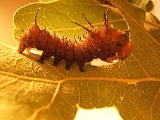
Apolysis
Encyclopedia

Epidermis (zoology)
The Epidermis is an epithelium that covers the body of an eumetazoan . Eumetazoa have a cavity lined with a similar epithelium, the gastrodermis, which forms a boundary with the epidermis at the mouth.Sponges have no epithelium, and therefore no epidermis or gastrodermis...
in arthropod
Arthropod
An arthropod is an invertebrate animal having an exoskeleton , a segmented body, and jointed appendages. Arthropods are members of the phylum Arthropoda , and include the insects, arachnids, crustaceans, and others...
s and related groups (Ecdysozoa
Ecdysozoa
Ecdysozoa is a group of protostome animals, including Arthropoda , Nematoda, and several smaller phyla. They were first defined by Aguinaldo et al. in 1997, based mainly on trees constructed using 18S ribosomal RNA genes...
). Since the cuticula of these animals is also the skeletal support of the body and is inelastic, it is shed during growth and a new covering of larger dimensions is formed. During this process, an arthropod becomes dormant for a period of time. Enzymes are secreted to digest the inner layers of the existing cuticle, detaching the animal from the outer cuticle. This allows the new cuticle to develop without being exposed to the environmental elements.
After apolysis, ecdysis
Ecdysis
Ecdysis is the moulting of the cuticula in many invertebrates. This process of moulting is the defining feature of the clade Ecdysozoa, comprising the arthropods, nematodes, velvet worms, horsehair worms, rotifers, tardigrades and Cephalorhyncha...
occurs. Ecdysis is the actual emergence of the arthropod into the environment and always occurs directly after apolysis. The newly emerged animal then hardens and continues its life.

